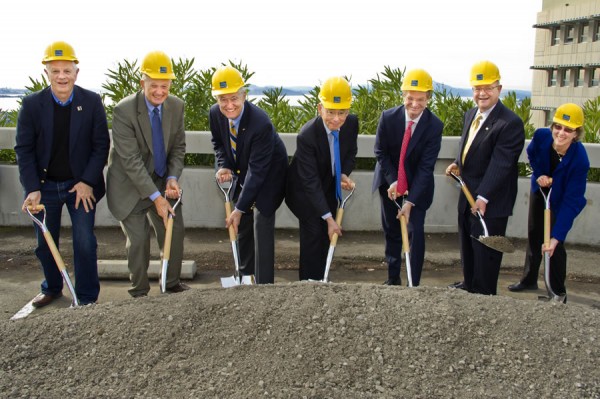Breaking Ground on the Computational Research and Theory Facility
February 1, 2012
Jon Bashor, Jbashor@lbl.gov, +1 510-486-5849
Department of Energy Secretary Steven Chu, along with Lawrence Berkeley National Laboratory (Berkeley Lab) and University of California leaders, broke ground on the Lab’s Computational Research and Theory (CRT) facility, Wednesday, Feb. 1. The CRT will be at the forefront of high-performance supercomputing research and be DOE’s most efficient facility of its kind.
Joining Secretary Chu as speakers were Berkeley Lab Director Paul Alivisatos, University of California President Mark Yudof, Energy Department's Office of Science Director Bill Brinkman, and UC Berkeley Chancellor Robert Birgeneau. The festivities were emceed by Associate Lab Director for Computing Sciences, Kathy Yelick. The speeches were followed by the symbolic “shovel and hard hat” photo opportunity.
The CRT will include an approximately 140,000 gross-square-foot, $145 million computer facility and office structure and associated infrastructure. The facility will accommodate up to approximately 300 staff and bring together these world-class programs within the Computing Sciences Division of Berkeley Lab under one roof, for the first time:
- The National Energy Research Scientific Computing Center (NERSC) is the Department of Energy's most scientifically productive supercomputing center serving more than 4,000 researchers who use NERSC to generate nearly 1,500 papers a year. Advances in physics, materials science, and chemistry would be impossible without the horsepower of NERSC's fastest computer, called Hopper, which is clocked at 1.05 quadrillion calculations per second.
- The Computational Research Division (CRD) at Berkeley Lab fosters scientific breakthroughs in applied computer science R&D, data management and analytics, networking and distributed computing, and applied mathematics.
- The Scientific Networking Division promotes global and scientific collaborations through its operation of the Energy Department's Energy Sciences Network (ESnet), which provides high-bandwidth connections for researchers worldwide to work together on such problems as global climate change, developing fusion energy and expanding our understanding of the Universe.
- Berkeley Lab Computing Sciences has joined with the University of California at Berkeley to create a program called Computational Science and Engineering at Berkeley (CSE). This program trains Ph.D. sudents in the increasingly important fields of large-scale simulation and analysis of large data sets. CSE also serves students at UC campuses in Davis, Merced, and Santa Cruz. These lectures are freely available online.

From left, Berkeley Mayor Tom Bates, Office of Science Director Bill Brinkman, UC Berkeley Chancellor Robert Birgeneau, Energy Secretary Steven Chu, Lab Director Paul Alivisatos, UC President Mark Yudof, and Associate Lab Director for Computing Sciences Kathy Yelick.
Secretary Chu also used the occasion to highlight President Obama’s State of the Union address and the administration’s commitment to America's leadership in scientific innovation, particularly in the area of energy.
About Computing Sciences at Berkeley Lab
High performance computing plays a critical role in scientific discovery. Researchers increasingly rely on advances in computer science, mathematics, computational science, data science, and large-scale computing and networking to increase our understanding of ourselves, our planet, and our universe. Berkeley Lab’s Computing Sciences Area researches, develops, and deploys new foundations, tools, and technologies to meet these needs and to advance research across a broad range of scientific disciplines.







 Instagram
Instagram YouTube
YouTube